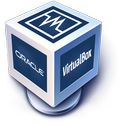Virtual Machine Software Choices
Tagged with code, linux, virtualbox, windows on September 27, 2024
 There are three free virtual machine software options available for the Linux platform. Only two of them are available for Windows. Prove me wrong. All of them do what they’re designed to do, with the native Linux choice being the most difficult to learn.
There are three free virtual machine software options available for the Linux platform. Only two of them are available for Windows. Prove me wrong. All of them do what they’re designed to do, with the native Linux choice being the most difficult to learn.
VirtualBox
Virtualbox is the virtual machine software I’ve been using for almost as long as I’ve been using Linux. An older version is usually available in the distribution’s repository. If you want a more up-to-date version, you can get it from the website. I don’t recommend getting the latest version, however, because it typically has bugs in it.
I made the mistake of installing the latest version when it became available (September 11, 2024). After trying to get certain things working correctly, I gave up and reinstalled the previous version. It’s still supported.
Make sure you download the extension pack, which you have to install from within VirtualBox. After installing everything, but before you create your first virtual machine, drop to the terminal and type:
sudo usermod -aG vboxusers username
Replace “username” with your username. After you install any Linux virtual machine, and if you want to share directories with the host, you have to drop to the terminal from within the virtual machine and type:
sudo usermod -aG vboxsf username
Replace “username” with the username you’re using on the virtual machine.
Backing up any virtual machine is a simple as copying the base directory and pasting it elsewhere. I usually have one copy of my Windows 11 Pro virtual machine available, just in case an update does something that can’t be fixed.
VMware
According to a blog post, “VMware Workstation Pro: Now Available Free for Personal Use”, the title says it all. I couldn’t figure out how to download it without registering on the Broadcom website. That is, until someone shared a direct link to the old repository: https://softwareupdate.vmware.com/cds/vmw-desktop/ws/
Installing the bundle required me to extract it and then drop to the terminal, type chmod +x for the extracted file and then run:
./VMware-Workstation-17.6.0-24238078.x86_64.bundle
When I ran it, I had to select the personal license. I installed a Linux distribution as a virtual machine, tested the interfaces, and then deleted the virtual machine. Although it works fine, I have no need to use VMWare Workstation Pro for anything.
Virtual Machine Manager
Although people call it various other things, like virt-manager and kvm, its official title is “Virtual Machine Manager”. That’s the title on their website, and it’s the title that appears when you run it. Since I didn’t know how to install it properly, I referred to this article: How to Install KVM on Linux Mint 21? It still works for Linux Mint 22.
There was one thing I had to do, that wasn’t mentioned. I had to drop to the terminal and type:
sudo chmod 666 /dev/kvm
That made it available to my username as well as root.
The website is lacking in documentation, so I had to read the online man page for “virsh” and some Ubuntu documentation to figure some things out. Again, I installed a Linux distribution as a virtual machine, tested the interfaces, and then deleted the virtual machine. Although it works fine, I have no need to use Virtual Machine Manager for anything.
The Verdict
VMware is a waste of time, and Virtual Machine Manager is difficult to use from the command line. I can create shortcuts to directly launch VirtualBox virtual machines. If I want to launch Virtual Machine Manager virtual machines from outside the GUI with the same functionality, I have to write scripts, or memorize some commands.
Some people say that Virtual Machine Manager virtual machines are way faster than VirtualBox virtual machines. I don’t know about that because Windows 11 as a virtual machine in VirtualBox seems to run as fast as it did as a host. Since I rarely run it, except for testing other Linux distributions, I’m happy to continue using VirtualBox.
Image by Oracle Corporation, GPLv2, via Wikimedia Commons
← Previous ArticleNext Article →